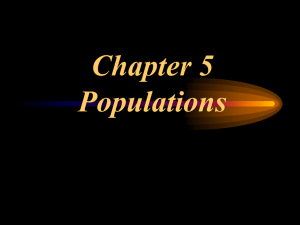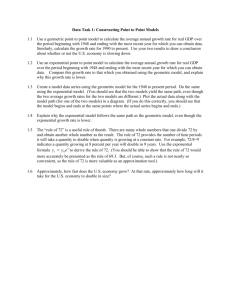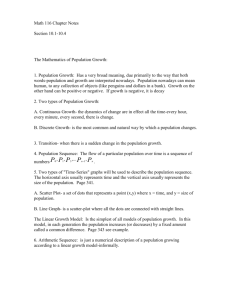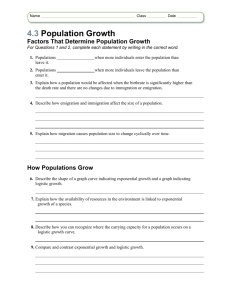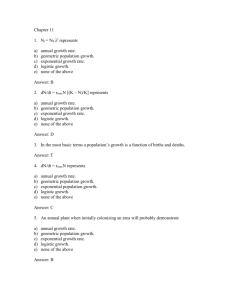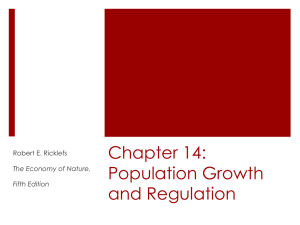Chapter 11 Population Growth Modeling Geometric Growth
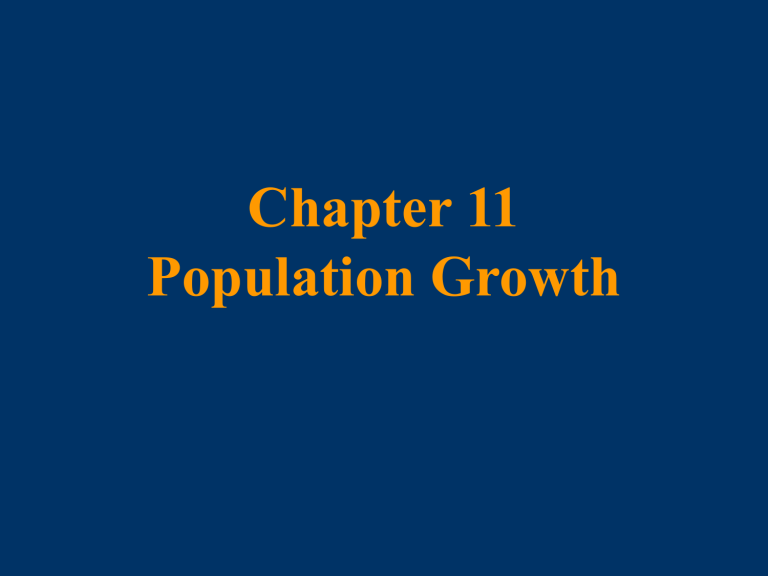
Chapter 11
Population Growth
Modeling Geometric Growth
• Geometric growth represents maximal population growth among populations with non-overlapping generations
• Successive generations differ in size by a constant ratio
• To construct a model for geometric population growth, recall the formula for geometric rate of increase:
= N t+1
N t
• e.g., geometric rate of increase for Phlox:
= 2408 = 2.4177
996
• To determine the growth of a non-overlapping population: by multiply by the size of the population at each beginning generation
Geometric growth for a hypothetical population of Phlox:
• Initial population size = 996
• Number of offspring produced by this population during the year:
N
1
= N
0 x or
996 x 2.4177 = 2408
• Calculating geometric growth from generation to generation:
N t
= N
0 x t
Where, N t is the number of individuals at time t ; N
0 is the initial population size; is the geometric rate of increase; t is the number of generations
Modeling Exponential Growth
• Overlapping populations growing at their maximal rate can be modeled as exponential growth: dN/dt = r N
– The change in the number of individuals over time is a function of r, the per capita rate of increase (a constant), times the population size (N) which is variable
– Recall that we can interpret r as b – d ; also, we can calculate r using the following formula: lnR
0
/T
• To determine the size of the exponentially growing population and any specified time ( t ):
N t
= N
0 e rt
– Where, e is a constant; the base of the natural logarithms, r is the per capita rate of increase, t is the number of time intervals
Exponential Growth in Nature
Example: Scots pine
• Bennett (1983) estimated population sizes and growth of postglacial tree populations by counting pollen grains from sediments (e.g., pollen grains/meter 2 /year)
• Assumption of this method?
• Results: populations of the species grew at exponential rates for about 500 years
Logistic Population Growth
• Environmental limitation is incorporated into another model of population growth called logistic population growth; characterized by a sigmoidal growth curve
• The population size at which growth has stopped is called carrying capacity (K), which is the number of individuals of a particular population that the environment can support
Examples of Sigmoidal Growth
What causes populations to slow their rates of growth and eventually stop growing at carrying capacity?
• A given environment can only support a certain number of individuals of a species population
• The population will grow until it reaches some kind of environmental limit imposed by shortage of food, space, accumulation of waste, etc.
Logistic Growth Equation
• Logistic growth equation was proposed to account for the patterns of growth shown by populations as the begin to use up resources: dN/dt = r m
N (K-N/K)
– where, r m is the maximum per capita rate of increase ( intrinsic rate of increase ) achieved by a population under ideal conditions
• Rearranged equation:
• Thus, as population size increases, the logistic growth rate becomes a smaller and smaller fraction of the exponential growth rate and when N=K, population growth stops
• The N/K ratio is sometimes called the “environmental resistance” to population growth
• As the size of a population
(N) gets closer and closer to
K, environmental factors increasingly affect further population growth
• The realized per capita rate of increase [ r = r m on population size
N(1-N/K)] depends
• When N is small, r approximates r m
• As N increases, realized r decreases until N = K; at that point realized r is zero
Limits to Population Growth:
Density Dependent vs. Density Independent Factors
• Density dependent factors
Birth rate or death rate changes as a function of population density
• Density independent factors
Same proportion of individuals are affected at any density

